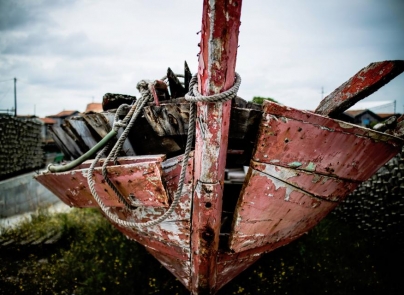Fabiola and Her Radical Charity

Fabiola and Her Radical Charity
On a Saturday before Easter, most likely in AD 393, Fabiola stood outside the full church of Saint John Lateran in Rome. She was dressed in sackcloth, with her hair disheveled, her unwashed cheeks streaming with tears.
It was a surprising sight. In the early church, such displays of open repentance were usually reserved for grave public sins. The most famous example was the humiliation, in 390, of Emperor Theodosius, who had ordered the massacre of thousands of citizens in Thessalonica. In Imperial Rome, Fabiola’s sin might have been considered less serious, even though most people, especially the patricians, knew about it.
Fabiola’s Sin
Years before, Fabiola had divorced her first husband, an action that was allowed by Roman civil law, even for trivial reasons. In fact, divorce was frequent among patrician families, who were free from monetary restraints. And Fabiola was a member of one of the most ancient and influential patrician families of Rome: the Fabii.
Even the church had justified her divorce, since her husband had been adulterous to say the least (the Church Father Jerome thought the details of his life were too shameful to be mentioned). In fact, Jerome thought that, by staying with her husband, Fabiola, on the basis of 1 Corinthians 6:16, would have shared in his corruptions.
But then Fabiola remarried while the first spouse was still alive, something the church would not allow. Because of this, she was excommunicated. Jerome agreed with this decision, even though he tried to excuse her by reason of her youth, since the Apostle Paul said “it is better to marry than to burn with passion” (1 Cor. 7:9).
As it is often the case with women from ancient and medieval times, we don’t have much information on Fabiola. The only description of her life was given by Jerome in a letter to Oceanus, a Roman nobleman and a relative of Fabiola, who had been corresponding with Jerome.
Due to these limitations, we don’t know about Fabiola’s youth and the progression of her faith. She might have met Jerome during his visits to Rome, and heard him teach or preach. The conviction of sin might have been brewing in her heart for some time. In any case, her decision to repent publicly of her second marriage and ask for the church’s forgiveness came only after her second husband had died.
The forgiveness she craved was immediately granted by Siricius, Bishop of Rome, who took her back into full communion with the church. From then on, Fabiola set out to devote her life to Christ.
Travels and Studies
She started out selling her goods and giving the money directly to the poor, or to monasteries and other Christian communities around Italy. “Either in her own person or else through the agency of reverend and trustworthy men she went from island to island and carried her bounty not only round the Etruscan Sea, but throughout the district of the Volscians, as it stands along those secluded and winding shores where communities of monks are to be found.”[1]
In 394, “against the advice of all her friends,” she decided to visit Jerome in Palestine, where he had been living since 385. She traveled with Oceanus, and took full advantage of Jerome’s experience as biblical translator and exegete. “Blessed Jesus, what zeal, what earnestness she bestowed upon the sacred volumes!” Jerome wrote. “In her eagerness to satisfy what was a veritable craving she would run through Prophets, Gospels, and Psalms: she would suggest questions and treasure up the answers in the desk of her own bosom. And yet this eagerness to hear did not bring with it any feeling of satiety.”[2]
Her questions seemed to be unending. For example, she asked, why “the soothsayer Balaam in prophesying of the future mysteries of Christ (Numbers 24:15-19) spoke more plainly of Him than almost any other prophet?” Many questions had to do with biblical names and places, often causing Jerome to admit his ignorance. To her insistence, he finally promised he would research those matters and dedicate the resulting essays to her.
Jerome would have loved to keep Fabiola with him, together with other Roman ladies who had made a similar choice. But, just the year following her arrival, when the Roman Empire panicked under threat of invasion by Huns, he and his followers had to go into hiding, and Fabiola decided to return to Rome. There, she once again devoted her life and resources to those in need. This is the vocation she finally chose, and the one that made her memorable.
Serving the Needy
Eventually, she joined forces with another Christian, Pammachius, a former senator, whose wife had recently died, and who shared Fabiola’s concern for the needy. Apparently, both Fabiola and Pammachius had the idea of opening a hostel of guest-house (xenodocheion) for needy travelers in Portus, a large harbor near the mouth of the River Tiber, a place swarming with sailors, merchants, immigrants, and pilgrims.
It soon became obvious that their efforts should be combined. With time, their building expanded to provide services to the community and to people afflicted by various illnesses. It was a place where, as Jerome explained, Fabiola “might gather sufferers out of the streets, and where she might nurse the unfortunate victims of sickness and want.”[3]
Institutions of this kind were, in some way, a Christian innovation. Already in 330, a xenodocheion was built in Antioch. Medical centers (nosokomeion), similar to today’s hospitals were also built in Antioch and, most famously, in Cappadocia, where Basil the Great oversaw a complex as large as a city. Most likely, Fabiola had heard of these efforts.
What distinguished Fabiola from most Christians who were involved in similar ventures was her total participation in the care of those who were most rejected and despised.
Jerome doesn’t spare the details of human suffering she encountered daily: “Need I speak of noses slit, eyes put out, feet half burnt, hands covered with sores? Or of limbs dropsical and atrophied? Or of diseased flesh alive with worms?”
And yet, Fabiola didn’t limit herself to being present and lending a compassionate hand. “Often did she carry on her own shoulders persons infected with jaundice or with filth. Often too did she wash away the matter discharged from wounds which others, even though men, could not bear to look at. She gave food to her patients with her own hand, and moistened the scarce breathing lips of the dying with sips of liquid.”[4]
Admittedly, not everyone could do what she did. “I know of many wealthy and devout persons who, unable to overcome their natural repugnance to such sights, perform this work of mercy by the agency of others, giving money instead of personal aid,” Jerome wrote. “I do not blame them and am far from construing their weakness of resolution into a want of faith. While however I pardon such squeamishness, I extol to the skies the enthusiastic zeal of a mind that is above it.”[5]
Jerome listed two reasons who Christians should show compassion when it would be easier to avert their eyes: in spite of their appearance, he said, all sufferers are human beings, and no one can feel immune from contracting the same conditions. “Let us then regard his wounds as though they were our own, and then all our insensibility to another's suffering will give way before our pity for ourselves.”[6]
We can safely assume that these words express Fabiola’s thoughts, even though she didn’t leave any written document.
News of Fabiola’s hostel spread throughout the empire, so much that Jerome could say, “The whole world knows that a home for strangers has been established at Portus.” She died in 399, only four years after returning to Rome, but her memory has lived on, causing other Christians to follow her example.
[1] Jerome, Letter 77, to Oceanus, 6, https://www.ccel.org/ccel/schaff/npnf206.v.LXXVII.html
[2] Ibid., 7
[3] Ibid., 6
[4] Ibid.
[5] Ibid.
[6] Ibid.





